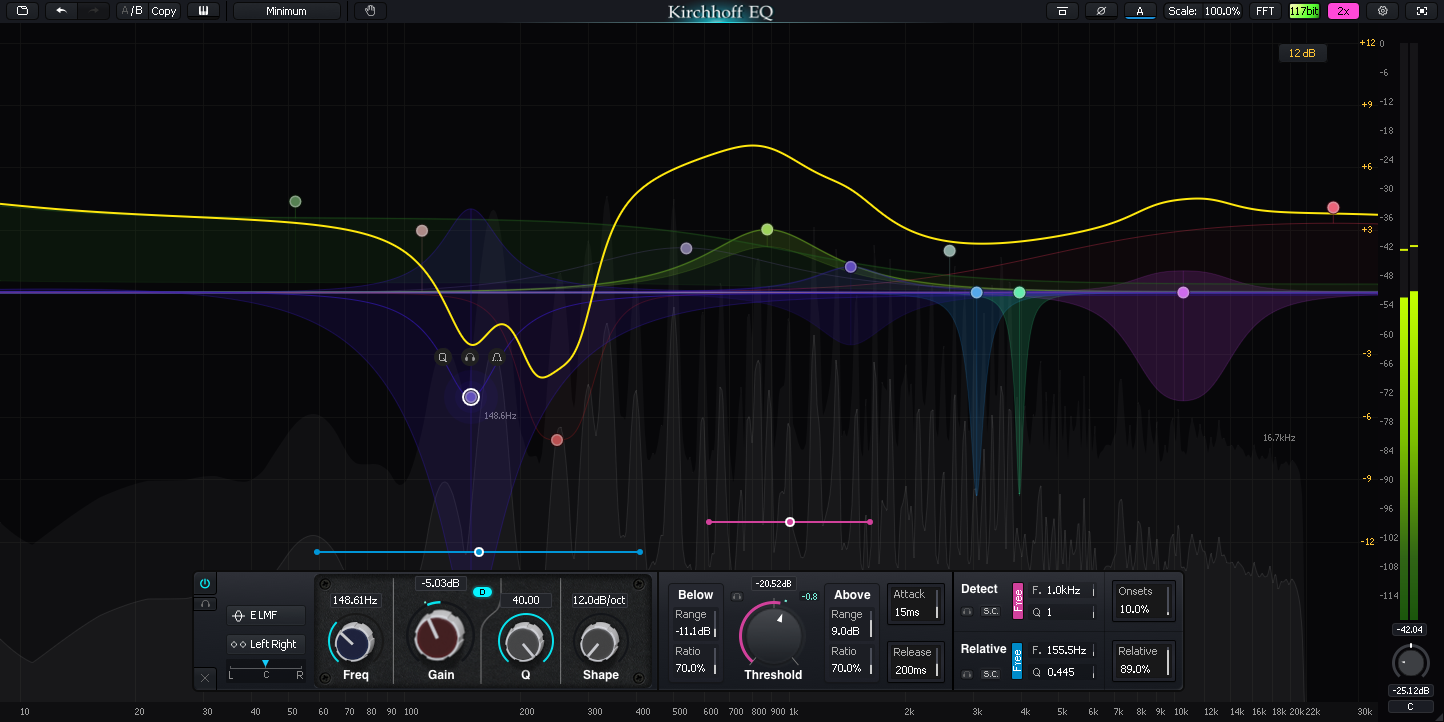REQ: Three-Body Technology Kirchhoff-EQ

ULTIMATE EQ PLUGIN WITH SUPERB DYNAMIC PROCESSING AND VINTAGE MODELS
Kirchhoff-EQ is an ultimate 32-band parametric EQ plugin built for all critical professional applications. It has refined sound quality, analogue-matched curves, 11 filter types with continuously variable shape and 30 vintage EQ types modelled from realworld devices. The builtin dynamic processing functions are highly flexible and have ultra-low distorsion. All these push Kirchhoff-EQ to a next-generation standard.
Equalizers will never be the same again.
Ultimate Sound Quality
Robust Nyquist-matched Transform
Through originally developed "Robust Nyquist-matched Transform", Kirchhoff-EQ has made digital-domain frequency response more approximate to its analogue counterparts without high frequency cramping as in regular IIR(infinite impulse response) equalizers. This technique is applied on all filter types in Kirchhoff-EQ.
High-Precision Processing
64-bits is mandatory and it's not negotiable. The internal processing of Kirchhoff-EQ is always in 64-bits (or 117-bits), regardless host DAW's current working precision.
Psychoacoustic Adaptive Filter Topologies
All linear filter structures should have same sound on paper. However in real-world application, round-off errors make every filter structure sound differently: some better in low frequency, some better in high frequency.
A technology called "Psychoacoustic Adaptive Filter Topologies" has been deployed in Kirchhoff-EQ. Filter structures change themselves to a "best fitting" state along with corresponding band frequency changes, making optimized sound quality in both low and high frequency.
Switchable Ultra-High 117-bits Processing
Since there's already 64-bits, why not go further? Kirchhoff-EQ uses a technique called "Double-Double" to make precision of internal processing reach 117 bits! This is the first equalizer in the world to reach such precision. You can switch between 64-bits and 117-bits at any time. It satisfies the most demanding ears.
* Linear-phase mode always use 64-bits as it is an FIR(finite impulse response) filter, and does not support 117-bits.
Filter Types
11 Unique Filter Types
low pass, high pass, band pass: continuously variable from 0 dB/oct to 96 dB/oct;
bell, notch: continuously variable from 12 dB/oct to 96 dB/oct;
low shelf, high shelf, tilt shelf: continuously variable from 6 dB/oct to 96 dB/oct;
flat tilt and flat top;
sword: has sharper slope than bell, specifically designed to "dig" out resonances.
Continuously variable slopes Filters
The slope of most filter types can be continuously changed from 0 dB/oct, 6 dB/oct or 12 dB/oct up to 96 dB/oct. Would you like to try a 8.125 dB/oct highpass?
30 Filter Types Modeled from Historic Vintage EQs!
Get vintage and modern at same time! We modeled 8 vintage EQ hardware units into Kirchhoff-EQ, in total of 30 EQ types. Benefit from Robust Nyquist-Matched Transform, every EQ type precisely matches the original hardware and won't cramp near Nyquist frequency. For a further step, unlike the original hardware that only allows to choose between several frequency positions, we modified the DSP model to make adjustable frequency points for all these types! Every type in these models can be used together with regular EQ types or other modeled types, and can be applied with dynamic functions (except lowpass and highpass types). This brings you more freedom and convenient operations.
* No non-linear behaviors were modeled. All vintage filter types only contain ideal linear parts of their physical model.
Zero-Latency/Analogue/Linear/Mixed Phase Modes
The phase mode of Kirchhoff-EQ is switchable between zero-latency mode, analogue mode, linear phase mode and mixed phase mode. To meet all your Phase relationship needs.
* No matter which phase mode currently in, if dynamic functions is turned on for a filter band, it will work on minimum-phase mode (won't affect other bands).
Mixed Phase Mode
The zero-latency and linear phase mode has very different sound. Kirchhoff-EQ provides a mixed mode that uses zero-latency when band frequency point is low, and uses linear phase when it is high. Each band could smoothly changed between minimum and linear phase mode according to their frequency.
* There is no noticeable crossover between filter types while in mixed phase mode, transition is seamless.
